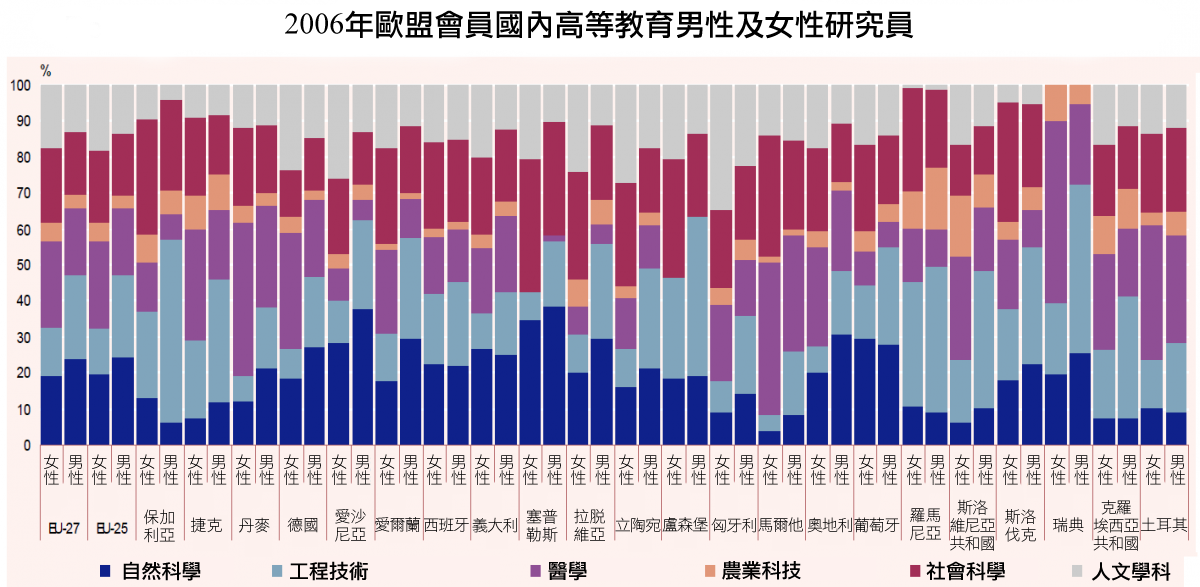數據驅動的文獻顯示男性和女性在下列方面的差距相當大:
-
垂直區隔
垂直區隔描述男性和女性之間依照特定領域的資歷水平的差異。數據一致顯示,不論在歐盟或美國,女性的職位比例皆隨職等增加而遞減。許多垂直區隔的其中一項結果是身為學術「把關人」的比例大幅不足,如助學金審查人、升等委員會成員、期刊編輯和國家研究院成員。

-
U. S. National Science Foundation (NSF). (2011). Women, Minorities, and Persons with Disabilities in Science and Engineering. Arlington, VA. Table 9-25.
-
Addis, E., & Pagnini, C. (2010). Meta-Analysis of Gender and Science Research Topic Report: Gender and Scientific Excellence. Luxembourg: Publications Office of the European Union.
Meulders, D., Plasman, R., Rigo, A., & O'Dorchai, S. (2010). Meta-Analysis of Gender and Science Research Topic Report: Horizontal and Vertical Segregation. Luxembourg: Publications Office of the European Union.
-
European Commission (2009). The Gender Challenge in Research Funding: Assessing the European National Scenes. Luxembourg: Office for Official Publications of the European Union.
-
-
水平區隔
水平區隔描述在教育程度或就業水平相等的女性和男性,如何在不同的科學次領域呈現群集效應。水平區隔明顯存在於科學和工程領域,以及人文學科和社會科學:
在美國和歐盟,女性在所有博士學位(博士或ISCED Level 6)的比例稍有不足,但在理工(S&E)博士學位的比例則是大幅不足:
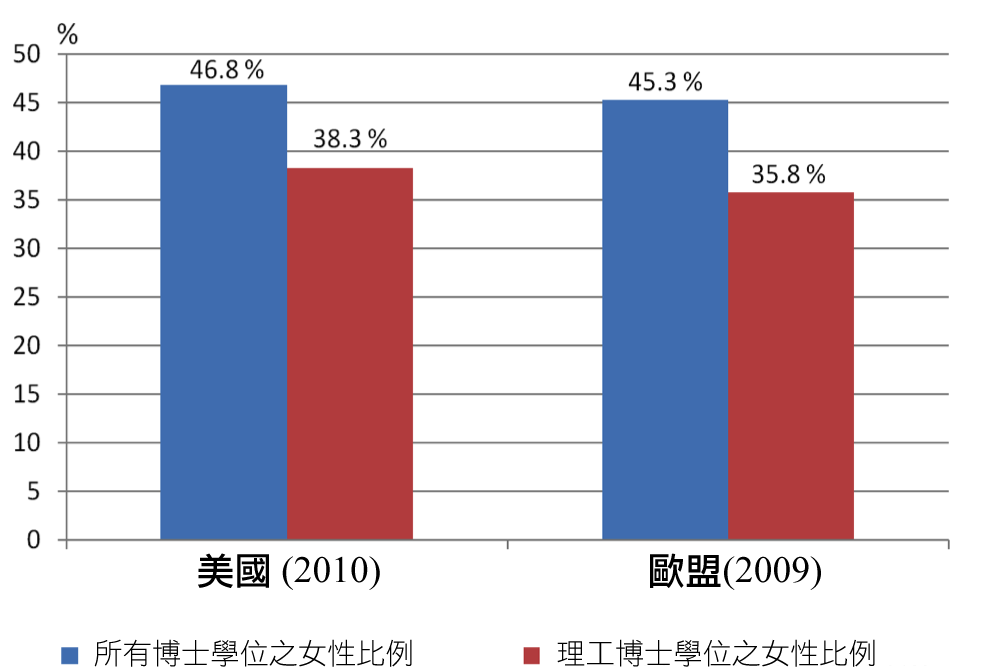
-
U.S. National Science Foundation. 2012. Doctorate Recipients, by Sex and Broad Field of Study: Selected Years, 1980-2010. Arlington, VA.
-
European Commission (2009). She Figures. Luxembourg: Publications Office of the European Union.
在理工領域中,女性在某些學科的比例比其他學科高。在美國和歐盟中,相較於物理科學或傳統的工程領域,如機械和電氣工程,女性在生命科學(如生物學)和環境領域(如環境工程)的比例較高。水平區隔也出現於醫學。例如:美國有28%的醫師是女性,而當中只有6%的神經外科醫師是女性。
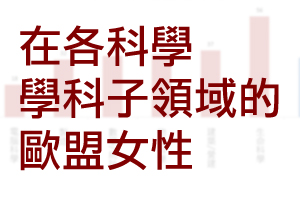
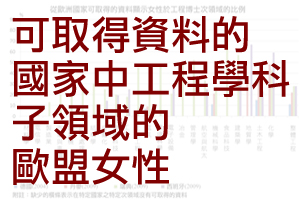
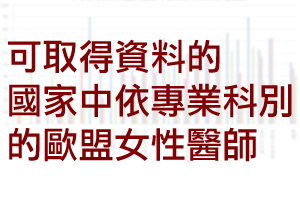
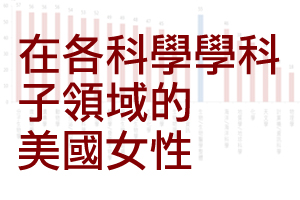
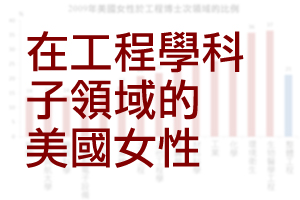
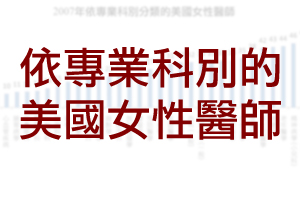
-
Statistika Centralbyrån. (2011). Antal Forskarexamina Efter Universitet / Högskola, Examenstyp, Nationellt Forskningsämne, Kön, Ålder och Tid. See Table 1 (Women Graduates), Table 2 (Men Graduates).
-
Statistics Denmark. (2011). Education and Culture Table PHD2: Doctorate Graduates by Main Areas, Gender, and Points in Time.
-
Instituto Nacional de Estadística. (2010). Doctoral Theses Passed, Academic Year 2008/2009, Engineering and Technology Area by University, Study, and Sex.
-
European Commission Expert Group on Gender and Employment. (2009). Gender Segregation in the Labour Market: Root Causes, Implications, and Policy Responses in the European Union. Luxembourg: Office for Official Publications of the European Union
-
Eurostat. (2009). Proportion of Female Physicians, Tertiary Level Academic Staff, and Managers Increasing. Eurostat News Release, March 6.
-
American Association of Medical Colleges (AAMC). (2008). Physician Specialty Data. AAMC Center for Workforce Studies Publications, November.
-
PROMETEA: Empowering Women Engineers in Industrial and Academic Research. (2006). Report on the State of the Art, Existing Quantitative Data, Identification of Gaps, and Methodological Overview. Luxemborg: Office for Official Publications of the European Union.
-
-
國家層級的研究開支
在國際上,國家的人均研究開支和該國女性研究人員的比例成反比關係。
在2009年,在58個取得資料的國家中,平均25%的女性研究人員當中每人每年平均花15萬美元在研發上;在支出較少的國家中,女性研究人員平均有40%。例如:德國支出17.2萬美元並且有25%的女性研究人員;阿根廷支出5.2萬美元,並且有52%的女性研究人員。(所有數額是以2009年的匯率換算當地貨幣,並針對購買力平價做調整。研究人員的開支和女性研究人員比例是以簡單的員工人數,非以全職約當數為基準)。
-
UNESCO (2005). Data Centre, Public Reports, Science and Technology, Table 4: Researchers by Sex (Full-Time Equivalent and Head Count) and Table 25: Gross Domestic Expenditure on Research and Development (GERD).
-
-
薪資
女性科學家和工程師的薪資平均低於其男性同業。這點在學術界和私人部門也成立,在美國、整個歐盟以及所有個別的歐盟成員國也成立。檢驗學歷、職業、工作經驗年資、每週工作時數和就業部門時,女性和男性薪資之間存在統計差異。
-
U.S. National Science Foundation, Women, Minorities, and Persons with Disabilities in Science and Engineering: 2011. Special Report NSF 11-309. Arlington, VA. Table 9-16 (208).
-
Meulders, D., O'Dorchai, S., Plasman, R., & Rigo, A. (2010).Meta-Analysis of Gender and Science Research Topic Report: Renger Wage Gap and Funding. Luxembourg: Publications Office of the European Union.
-
European Commission. (2007).Renumeration of Researchers in the Public and Private Commercial Sectors. Luxembourg: Official Publications Office of the European Communities.
-
Umbach, P. (2007). Gender Equity in the Academic Labor Market: An Analysis of Academic Disciplines. Research in Higher Education, 48 (2), 169-192.
-
Toutkoushian, R.K., & Conley, V.M. (2005). Progress for Women in Academe, Yet Inequities Persist: Evidence from NSOPF- 99. Research in Higher Education, 46 (1), 1-28.
-
-
補助經費
-
補助金申請率
歐洲:一份33個歐盟國的研究發現,「女性比男性更不可能申請到補助金。」顯著的差異存在於各國、學術領域和補助金種類;在性別平等程度高的國家,女性和男性在某些學科的申請率相當(歐盟委員會,2009;Plantenga, 2009)。 美國:在美國,男性和女性同樣可能申請到國立衛生研究院(NIH)青年補助金,而女性較不可能申請到晚期職涯補助金(Ley等人,2008)。在三個聯邦資助計畫(NIH、NSF和美國農業部[USDA])的廣泛研究中,女性占研究人員的25%,並申請到21-28%的補助金(Hosek等人,2005),這表示女性和男性同樣可能申請到整個聯邦資助經費本身,但不一定同樣可能申請到特定的資助金額—參見B項。
評估女性和男性尋求資助的可能性具有挑戰性。雖然補助金申請人的人數和性別是由大型補助機構收集,但評估有資格申請特定經費的女性和男性的人數通常很困難—垂直區隔是指具有相似學術資格的男性和女性在機構內的職位不同,而補助資格準則可能取決於職位(歐盟委員會,2009;Wilson等人,2009)。 -
成功率
在歐盟,一份2009年的28個歐盟國家的研究發現,在21個國家中,女性申請經費的成功率比男性較低。(歐盟委員會,2009)
這些數據並未檢驗與成功申請補助相關的因素,而且未直接與下列的美國數據相比。
在美國,研究人員發現,從2003到2007年,「不論學歷,幾乎所有[NIH]補助金的資助成功率對於男性和女性基本上是平等的」(Ley等人,2008)。檢驗學科、制度、經驗和過去的研究成果,女性和男性也同樣成功取得NSF 和USDA的經費(Hosek等人,2005)。但是對於評估研究生產力的方法有爭議。
-
申請及取得的補助金額
在美國,在2001到2003會計年度,檢驗學科、制度、經驗和過去的研究成果等因素時,成功申請到NSF 和USDA經費的女性申請人取得與其男性同業相同的金額。成功申請到NIH經費的女性申請人僅獲得男性申請人63%的補助;女性僅取得最高金額經費的13%(前1%)。針對其他因素檢驗數據時仍存在此差異。NIH公共數據不能反映出個別申請人申請的資助金額(Hosek等人,2005)。
在一份美國菁英機構的醫療研究人員的研究中,學術排名較低的女性申請及取得的經費較男性少。學術地位較高的女性和男性可申請及取得經費補助金額相當。
-
Unidad de Mujeres y Ciencia. (2011). White Paper on the Position of Women in Science in Spain.
-
European Commission (2009). The Gender Challenge in Research Funding: Assessing the European National Scenes. Luxembourg: Office for Official Publications of the European Union. -
Plantenga, J., Remery, C., Figueiredo, H., & Smith, M. (2009). Towards a European Union Gender Equality Index. Journal of European Social Policy, 19 (1),. 19-33. -
Wilson, J., Marks, G., Noone, L., & Hamilton-Mackenzie, J. (2009). Retaining a Foothold on the Slippery Paths of Academia: University Women, Indirect Discrimination and the Academic Marketplace. Gender and Education, 22 (5),535-545.
-
Bailyn, L. (2008). Comment on "Gender Differences in Research Grant Applications and Funding Outcomes for Medical School Faculty." Journal of Women's Health, 17 (2), 303-304.
-
Jacobsson, C. (2008). Gender and Excellence Country Report: Sweden. Luxembourg: Office for Official Publications of the European Communities.
-
Ley, T., & Hamilton, B. (2008). The Gender Gap in NIH Grant Applications. Science, 322, 1472-1474.
-
Waisbren, S., Bowles, H., Hasan, T., Zou, K., Emans, S., Goldberg, C., Gould, S., Levine, D., Liberman, E., Koeken, M., Longtine, J., Nadelson, C., Patenaude, A., Quinn, D., Randolph, A., Solet, J., Ullrich, N., Weitzman, P., & Christou, H. (2008). Gender Differences in Research Grant Applications and Funding Outcomes for Medical School Faculty. Journal of Women's Health, 17 (2), 207-214.
-
Carnes, M., Geller, S., Fine, E., Sheridan, J., & Handelsman, J. (2005). National Institutes of Health (NIH) Director's Pioneer Awards: Could the Selection Process be Biased Against Women?Journal of Women's Health, 14 (8), 684-691.
-
Hosek, S., Cox, A., Ghosh-Dastidar, B., Kofner, A., Ramphal, N., Scott, J., & Berry, S. (2005). Gender Differences in Major Federal External Grant Programs. Santa Monica: RAND Corporation.
-
Blagojević, M., Bundule, M., Burkhardt, A., Calloni, M., Ergma, E., Glover, J., Groo, D., Havelková, H., Mladenić, D., Oleksy, E.H., Sretenova, N., Tripsa, M., Velichová, D., & Zvinliene, A. (2004). Waste of Talents: Turning Private Struggles into a Public Issue- Women and Science in the ENWISE Countries. Luxembourg: Office for Official Publications of the European Communities.
-
-
生產力
出版率和申請專利率通常被當作理工領域生產力的衡量標準。補助金審查人通常會考慮這種衡量標準,並用於學術界和私人部門雇用和升遷上的決策。
-
出版
女性研究人員出版率較男性稍低,但當檢驗體制種類、年資和資源時,差異會消失(Xie等人,2003)。
-
專利
一份學術生命科學家的研究發現,女性比男性較不可能被命名在專利中,即使檢驗包括「生產力、網絡、領域和雇主屬性」等變數。這項差異經發現會隨時間縮小(Ding等人,2006)。「檢驗教育程度和工作經歷變數」的研究發現類似的差異(Whittington等人,2008)。
衡量專利在不同領域被引用的廣泛程度,藉此對專利分配一個「普遍性」分數,並且對研究人員分配一個相當於被命名之所有專利平均分數的「普遍性分數」時,女性學術研究人員的普遍性分數稍微比男性高(Whittington等人,2005)。
與出版的情形相同,並非所有專利都是相等的價值。評估專利的價值—其商業價值、學術價值等─都具有挑戰性(Azoulay等人,2009)。這使得試圖使用專利當作個別研究人員的生產力指標變得複雜化。
-
Azoulay, P., Ding, W., & Stuart, T. (2009). The Impact of Academic Patenting on the Rate, Quality, and Direction of (Public) Research Output. The Journal of Industrial Economics, 57 (4), 637-676.
-
Whittington, K. (2009). Patterns of Male and Female Dissemination in Public and Private Science. In R.B. Freeman & D.F. Goroff (Eds.), Science and Engineering Careers in the United States: An Analysis of Markets and Employment (pp. 195-228). Chicago: University of Chicago Press.
-
Whittington, K., & Smith-Doerr, L. (2008). Women Inventors in Context: Disparities in Patenting across Academia and Industry. Gender & Society, 22 (2), 194-218.
-
Ding, W., Murray, F., & Stuart, T. (2006). Gender Differences in Patenting in the Academic Life Sciences. Science, 313, 665-667. -
Whittington, K., & Smith-Doerr, L. (2005). Gender and Commercial Science: Women's Patenting in the Life Sciences. Journal of Technology Transfer, 30 (4), 355-370.
-
Xie, Y., & Shauman, K. (2003). Women in Science: Career Processes and Outcomes. Cambridge, MA: Harvard University Press.
-

